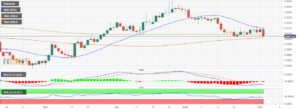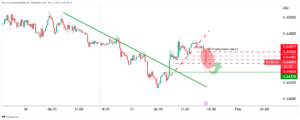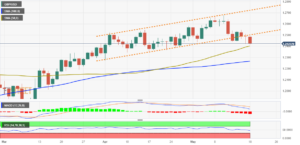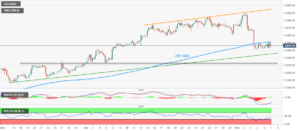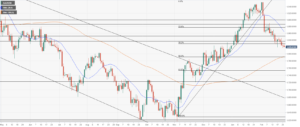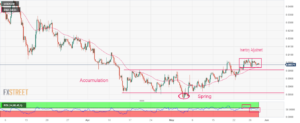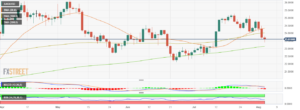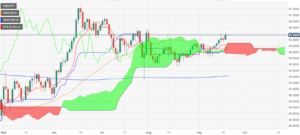
- DXY Index is above the 20-day SMA at 104.05.
- US NFPs from November accelerated, as did Average Hourly Earnings. The Unemployment Rate declined.
- US is set to report CPI inflation next Tuesday.
The US Dollar (USD) continued to command the financial markets as it soared to the 104.05 mark, primarily because of positive labor market cues and a surge in yields, which suggests that markets are delaying rate cuts in 2024. The gains for the USD Index (DXY) were fueled by economic reports from November, prominently Average Hourly Earnings, Unemployment Rate and Nonfarm Payrolls, all of which collectively fuelled hawkish bets on the Federal Reserve (Fed).
Moderating US inflation figures from October fuelled dovish expectations regarding the Federal Reserve’s stance at the beginning of November. However, Fed officials’ signals considering further tightening are dampening these expectations, and strong labor market data reaffirms this cautious stance by the bank, which is requesting further evidence on the economy cooling down. The upcoming inflation data from November and the Fed meeting next week will be critical determinants for the USD’s short-term trajectory.
Daily Market Movers: US Dollar rising on the strength of labor market data
- The US dollar is making gains today, riding on a wave of strong labor market data and climbing yields.
- According to the US Bureau of Labor Statistics, November’s Average Hourly Earnings MoM figures revealed a better-than-expected increase of 0.4%, exceeding both consensus and previous numbers of 0.3% and 0.2%, respectively.
- The Nonfarm Payrolls for November showed 199K new jobs were added to the US economy, surpassing consensus expectations of 180K and the preceding number of 150K jobs.
- The Unemployment Rate came in at 3.7%, lower than the anticipated figure of 3.9%.
- US bond yields are rising, with rates for 2-year, 5-year and 10-year bonds rising to 4.72%, 4.24%, and 4.23%, respectively.
- As per the CME FedWatch Tool, the market expects no rate hike in the December Fed meeting but anticipates less easing in 2024.
- Next week will see Tuesday’s release of the Headline and Core Consumer Price Index (CPI) for November, which will likely shape the expectations for the next Fed decisions.
Technical Analysis: US Dollar bulls step in, but bears are still in command
The indicators on the daily chart reflect a short-term conflicted landscape for the US Dollar. The Relative Strength Index (RSI) position is on a positive slope, albeit in negative territory. This signals growing buying momentum, but it isn’t robust enough to draw a definitive recovery. On the other hand, the histogram of the Moving Average Convergence Divergence (MACD) indicator paints a similar picture with green bars, which suggests that the selling pressure is declining.
Regarding the Simple Moving Averages (SMAs), the index sits above the 20-day SMA, yet below the 100-day SMA. Nonetheless, with respect to the 200-day SMA, it is clear that the index is operating in a generally bullish zone.
The resilience of bulls, in combination with bears taking a breather, insinuates that the selling force could be losing dominance over the buying force. However, the US Dollar Index needs to make a sustained move above the 100-day SMA for a change in the prevailing selling momentum. Until then, the overall technical outlook remains tentatively balanced toward the downside.
Support levels: 104.00 (20-day SMA), 103.50, 103.30.
Resistance levels: 104.40 (100-day SMA), 104.50,104.70.
Nonfarm Payrolls FAQs
Nonfarm Payrolls (NFP) are part of the US Bureau of Labor Statistics monthly jobs report. The Nonfarm Payrolls component specifically measures the change in the number of people employed in the US during the previous month, excluding the farming industry.
The Nonfarm Payrolls figure can influence the decisions of the Federal Reserve by providing a measure of how successfully the Fed is meeting its mandate of fostering full employment and 2% inflation.
A relatively high NFP figure means more people are in employment, earning more money and therefore probably spending more. A relatively low Nonfarm Payrolls’ result, on the either hand, could mean people are struggling to find work.
The Fed will typically raise interest rates to combat high inflation triggered by low unemployment, and lower them to stimulate a stagnant labor market.
Nonfarm Payrolls generally have a positive correlation with the US Dollar. This means when payrolls’ figures come out higher-than-expected the USD tends to rally and vice versa when they are lower.
NFPs influence the US Dollar by virtue of their impact on inflation, monetary policy expectations and interest rates. A higher NFP usually means the Federal Reserve will be more tight in its monetary policy, supporting the USD.
Nonfarm Payrolls are generally negatively-correlated with the price of Gold. This means a higher-than-expected payrolls’ figure will have a depressing effect on the Gold price and vice versa.
Higher NFP generally has a positive effect on the value of the USD, and like most major commodities Gold is priced in US Dollars. If the USD gains in value, therefore, it requires less Dollars to buy an ounce of Gold.
Also, higher interest rates (typically helped higher NFPs) also lessen the attractiveness of Gold as an investment compared to staying in cash, where the money will at least earn interest.
Nonfarm Payrolls is only one component within a bigger jobs report and it can be overshadowed by the other components.
At times, when NFP come out higher-than-forecast, but the Average Weekly Earnings is lower than expected, the market has ignored the potentially inflationary effect of the headline result and interpreted the fall in earnings as deflationary.
The Participation Rate and the Average Weekly Hours components can also influence the market reaction, but only in seldom events like the “Great Resignation” or the Global Financial Crisis.
- SEO Powered Content & PR Distribution. Get Amplified Today.
- PlatoData.Network Vertical Generative Ai. Empower Yourself. Access Here.
- PlatoAiStream. Web3 Intelligence. Knowledge Amplified. Access Here.
- PlatoESG. Carbon, CleanTech, Energy, Environment, Solar, Waste Management. Access Here.
- PlatoHealth. Biotech and Clinical Trials Intelligence. Access Here.
- Source: https://www.fxstreet.com/news/us-dollar-trades-with-gains-amid-strong-labor-market-data-and-rising-yields-202312081820
- :has
- :is
- :where
- 2%
- 2% Inflation
- 2024
- 30
- 32
- 35%
- 40
- 50
- 70
- a
- above
- accelerated
- added
- After
- All
- also
- an
- analysis
- and
- Animate
- Anticipated
- anticipates
- ARE
- AS
- At
- average
- Balanced
- Bank
- bars
- BE
- Bears
- because
- Beginning
- below
- Bets
- bigger
- bond
- Bond yields
- Bonds
- both
- Bullish
- Bulls
- Bureau
- bureau of labor statistics
- but
- buy
- Buying
- by
- came
- CAN
- Cash
- cautious
- change
- Chart
- clear
- Climbing
- CME
- collectively
- combat
- combination
- come
- Commodities
- compared
- component
- components
- Consensus
- considering
- consumer
- consumer price index
- content
- continued
- Convergence
- Core
- Correlation
- could
- CPI
- crisis
- critical
- cuts
- daily
- data
- December
- decisions
- Declining
- definitive
- deflationary
- delaying
- DID
- Divergence
- Dollar
- dollars
- Dominance
- Dovish
- down
- downside
- draw
- during
- Dxy
- earn
- Earning
- Earnings
- easing
- Economic
- economy
- effect
- either
- employed
- employment
- ends
- enough
- events
- evidence
- excluding
- expanded
- expectations
- expected
- expects
- Fall
- FAQ
- farming
- Fed
- fed meeting
- Federal
- federal reserve
- Figure
- Figures
- financial
- financial crisis
- Find
- For
- Force
- fostering
- from
- fueled
- full
- further
- Gains
- generally
- Global
- global financial
- Global Financial Crisis
- Gold
- gold price
- Green
- Growing
- hand
- Have
- Hawkish
- headline
- helped
- High
- High inflation
- higher
- Hike
- HOURS
- How
- However
- HTTPS
- if
- Impact
- in
- Increase
- index
- Indicator
- Indicators
- industry
- inflation
- inflation figures
- Inflationary
- influence
- interest
- Interest Rates
- investment
- isn
- IT
- ITS
- Jobs
- jobs report
- jpg
- labor
- labor market
- landscape
- least
- less
- levels
- like
- likely
- losing
- Low
- lower
- MACD
- major
- make
- Making
- mandate
- mark
- Market
- Market Data
- market reaction
- Markets
- mean
- means
- measure
- measures
- meeting
- module
- mom
- Momentum
- Monetary
- Monetary Policy
- money
- Month
- monthly
- more
- most
- move
- Movers
- moving
- moving average
- moving averages
- needs
- negative
- negative territory
- New
- next
- next week
- nfp
- no
- Nonfarm
- Nonfarm Payrolls
- November
- number
- numbers
- october
- of
- officials
- on
- ONE
- only
- operating
- or
- Other
- Ounce of Gold
- out
- Outlook
- over
- overall
- part
- participation
- Payrolls
- People
- per
- picture
- plato
- Plato Data Intelligence
- PlatoData
- policy
- position
- positive
- potentially
- pressure
- previous
- price
- primarily
- probably
- providing
- raise
- rally
- Rate
- Rate Hike
- Rates
- reaction
- reaffirms
- recovery
- reflect
- regarding
- relative
- relative strength index
- Relative Strength Index (RSI)
- relatively
- release
- remains
- report
- Reports
- requires
- Reserve
- resilience
- respect
- respectively
- result
- Revealed
- riding
- rising
- robust
- rsi
- s
- see
- seldom
- Selling
- set
- Shape
- short-term
- showed
- signals
- similar
- Simple
- sits
- Slope
- SMA
- SMAs
- soared
- specifically
- Spending
- stance
- starts
- statistics
- staying
- Step
- Still
- stimulate
- strength
- strong
- Struggling
- Successfully
- Suggests
- Supporting
- surge
- surpassing
- sustained
- T
- taking
- Technical
- tends
- territory
- than
- that
- The
- the Fed
- their
- Them
- then
- therefore
- These
- they
- this
- tightening
- times
- to
- today
- tool
- toward
- trajectory
- triggered
- Tuesday
- typically
- unemployment
- unemployment rate
- until
- upcoming
- us
- US Dollar
- US Dollars
- US economy
- us inflation
- USD
- usually
- value
- vice
- Wave
- week
- weekly
- were
- when
- which
- will
- with
- within
- Work
- yet
- yields
- zephyrnet

